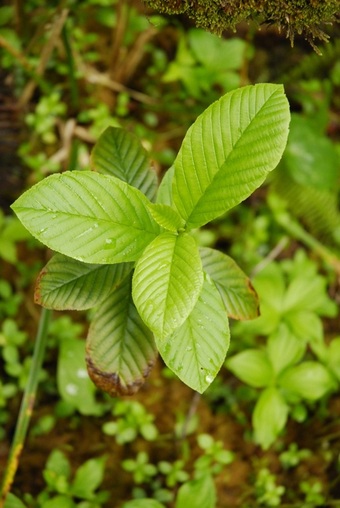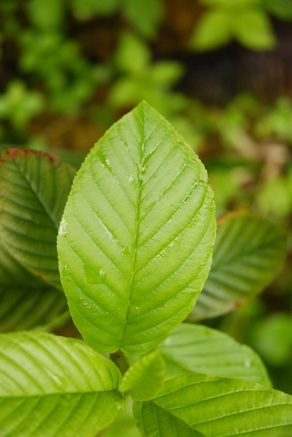Cascara, cascara buckthorn • Rhamnus purshiana, Frangula purshiana
Identification
Cascara, a deciduous shrub or small tree, has smooth silvery-grey bark and distinctive leaves. The glossy green leaves are strongly marked by pinnate pairs of parallel veins, creating a furrowed effect across the leaf surface. The leaves are 6-12 cm long, egg to oblong in shape, and are finely toothed. Clusters of small greenish-yellow flowers form along the stem at the leaf axils. Cascara bears small bluish-black to purplish-black berries.
Habitat & Range
Cascara grows in somewhat dry to wet locations from low to middle elevations. It is commonly found in the shaded understory of mixed woods. It is also found in thickets and in swampy locations. It is mostly found in southern British Columbia; it is common in the southwest, and less common but not infrequent in the south-central and southeastern areas of the province. It is found in western North America from BC to California and east to Montana and Idaho.
Similar Species
The leaves of red alder (Alnus rubra) and Sitka alder (Alnus viridis ssp. sinuata) lack the washboard-like veins of cascara and are less glossy. Red alder leaves are coarsely-toothed, while Sitka alder leaves are doubly saw-toothed. As well, red alder grows larger and is more tree-like.
Human Uses
Cascara berries are edible but not especially tasty. The bitter bark is a proven laxative; cascara is traditionally used in coastal First Nations medicine for this and a variety of other purposes; the plants also has non-medicinal uses such as in dye and tools. Cascara is harvested for use in commercial laxatives. It is not yet cultivated on a large scale, but the decline of wild trees from over-harvesting may make cultivation necessary.
iNaturalist
https://www.inaturalist.org/taxa/77156-Frangula-purshiana
Cascara, a deciduous shrub or small tree, has smooth silvery-grey bark and distinctive leaves. The glossy green leaves are strongly marked by pinnate pairs of parallel veins, creating a furrowed effect across the leaf surface. The leaves are 6-12 cm long, egg to oblong in shape, and are finely toothed. Clusters of small greenish-yellow flowers form along the stem at the leaf axils. Cascara bears small bluish-black to purplish-black berries.
Habitat & Range
Cascara grows in somewhat dry to wet locations from low to middle elevations. It is commonly found in the shaded understory of mixed woods. It is also found in thickets and in swampy locations. It is mostly found in southern British Columbia; it is common in the southwest, and less common but not infrequent in the south-central and southeastern areas of the province. It is found in western North America from BC to California and east to Montana and Idaho.
Similar Species
The leaves of red alder (Alnus rubra) and Sitka alder (Alnus viridis ssp. sinuata) lack the washboard-like veins of cascara and are less glossy. Red alder leaves are coarsely-toothed, while Sitka alder leaves are doubly saw-toothed. As well, red alder grows larger and is more tree-like.
Human Uses
Cascara berries are edible but not especially tasty. The bitter bark is a proven laxative; cascara is traditionally used in coastal First Nations medicine for this and a variety of other purposes; the plants also has non-medicinal uses such as in dye and tools. Cascara is harvested for use in commercial laxatives. It is not yet cultivated on a large scale, but the decline of wild trees from over-harvesting may make cultivation necessary.
iNaturalist
https://www.inaturalist.org/taxa/77156-Frangula-purshiana
References
Government of Canada. (2012). Rhamnus purshiana DC. (Cascara). Canadian Medicinal Crops. Agriculture and Agri-Food Canada. Accessed 19/12/2014.
Pojar, J. and MacKinnon, A. (1994). Plants of Coastal British Columbia. Vancouver, BC: Lone Pine Publishing. P. 90.
Province of British Columbia (2014). Cascara. Tree Book. BC Ministry of Forests, Lands, and Natural Resource Operations. Accessed 19/12/2014.
Rhamnus purshiana DC. In Klinkenberg, Brian. (Ed.). E-Flora BC: Electronic Atlas of the Plants of British Columbia. Lab for Advanced Spatial Analysis, Department of Geography, University of British Columbia, Vancouver. Accessed 19/12/2014.
Authors and editors of page
Kelly Fretwell and Brian Starzomski (2014).
Government of Canada. (2012). Rhamnus purshiana DC. (Cascara). Canadian Medicinal Crops. Agriculture and Agri-Food Canada. Accessed 19/12/2014.
Pojar, J. and MacKinnon, A. (1994). Plants of Coastal British Columbia. Vancouver, BC: Lone Pine Publishing. P. 90.
Province of British Columbia (2014). Cascara. Tree Book. BC Ministry of Forests, Lands, and Natural Resource Operations. Accessed 19/12/2014.
Rhamnus purshiana DC. In Klinkenberg, Brian. (Ed.). E-Flora BC: Electronic Atlas of the Plants of British Columbia. Lab for Advanced Spatial Analysis, Department of Geography, University of British Columbia, Vancouver. Accessed 19/12/2014.
Authors and editors of page
Kelly Fretwell and Brian Starzomski (2014).








